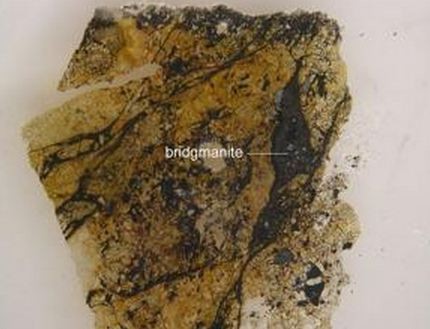Earth's Most Abundant Mineral is Seen for the First Time and is Given a Name
| Arthur Dominic Villasanta | | Jun 18, 2014 01:50 AM EDT |
Bridgmanite
Believe it or not but the Earth's most abundant mineral doesn't have a name and hasn't been seen, until now.
What on Earth is the Earth's most abundant mineral?
If you answered quartz, you'd only be partially correct. Quartz is the commonest mineral in the continental crust.
Like Us on Facebook
If you answered feldspar, you'd also be partly correct Feldspar is the most common mineral in the whole crust.
But what is the commonest mineral in the whole, entire Earth? It's olivine.
That name won't ring a bell in anyone except geologists, mineralogists and trivia nuts.
Olivine? Scientifically, olivine is known as the compound (Mg+2, Fe+2)2SiO4.
Depending on its structures at different pressures, olivine is also known as wadsleyite or ringwoodite, the mineral that holds most of the world's water inside its structure. But there has never been one name for this elusive mineral. That's changed.
For the first time, scientists have gotten a glimpse of the elusive mineral in nature. The mineral they saw is enclosed inside a 4.5 billion year-old meteorite. This discovery finally led scientists to studying this "invisible" mineral and giving it a new official name - bridgmanite.
It's named after Percy Bridgman, a physicist who won the 1946 Nobel Prize for his work on high pressure physics.
Bridgmanite is the name approved for the magnesium-silicate mineral formerly known by its chemical components and crystal structures as silicate-perovskite.
Silicate perovskite could account for up to 93% of the lower mantle. Its magnesium form is considered the most abundant mineral in the Earth.
Bridgmanite, or the mineral formerly referred to as a silicate perovskite, only exists at the high temperatures and pressures of the Earth's lower mantle some 400 to 1800 miles below the Earth's surface.
Although laboratory tests and models said it existed, geologists have never been able to see bridgmanite or characterize its structure. A team of mineralogists led by Chi Ma of Caltech and Oliver Tschauner, of the University of Nevada, Las Vegas decided to study the Tenham meteorite that landed in Queensland, Australia in 1879.
More specifically, they examined the meteorite's "shock-induced melt veins," which are scars of past violent collisions. Using a technique called synchrotron X-ray diffraction, the team characterized the mineral's molecular makeup (MgSiO3) and structure.
This paved the way for finally naming this abundant mineral.
Why did it take so long to name bridgmanite, bridgmanite?
That's because the International Mineralogical Association only allows minerals to be named when their structures are known. The IMA promotes the science of mineralogy and to standardize the nomenclature of the over 4,000 known mineral species.
It is a very exciting discovery, said Ma and Tschauner. We finally tracked down natural silicate-perovskite (now bridgmanite) in a meteorite after a five-year investigation, and got to name the most abundant mineral on Earth. How cool is that, they told the science website, Live Science.
Ma said scientists have been searching for the mineral for a long time since one must know a mineral's chemical composition and crystal structure to identify a mineral.
Scientists believe bridgmanite likely resides in the lower mantle, an area between the transition zone in the mantle and the core-mantle boundary, or between the depths of 670 and 2,900 kilometers.
Ma said the Tenham meteorite is "highly shocked," meaning it endured high temperatures and pressures as it smashed into other rocks in space. Those impacts created "shock veins" of minerals within the meteorites.
"Scientists have identified high-pressure minerals in its shock-melt veins since 1960s. Now we have identified bridgmanite," Tschauner said.
Ma and Tschauner sent their data for review to the International Mineralogical Association's Commission on New Minerals, Nomenclature and Classification. The commission approved the mineral and new name on June 2.
©2015 Chinatopix All rights reserved. Do not reproduce without permission
EDITOR'S PICKS
-

Did the Trump administration just announce plans for a trade war with ‘hostile’ China and Russia?
-

US Senate passes Taiwan travel bill slammed by China
-

As Yan Sihong’s family grieves, here are other Chinese students who went missing abroad. Some have never been found
-

Beijing blasts Western critics who ‘smear China’ with the term sharp power
-

China Envoy Seeks to Defuse Tensions With U.S. as a Trade War Brews
-

Singapore's Deputy PM Provides Bitcoin Vote of Confidence Amid China's Blanket Bans
-

China warns investors over risks in overseas virtual currency trading
-

Chinese government most trustworthy: survey
-

Kashima Antlers On Course For Back-To-Back Titles
MOST POPULAR
LATEST NEWS
Zhou Yongkang: China's Former Security Chief Sentenced to Life in Prison

China's former Chief of the Ministry of Public Security, Zhou Yongkang, has been given a life sentence after he was found guilty of abusing his office, bribery and deliberately ... Full Article
TRENDING STORY

China Pork Prices Expected to Stabilize As The Supplies Recover

Elephone P9000 Smartphone is now on Sale on Amazon India

There's a Big Chance Cliffhangers Won't Still Be Resolved When Grey's Anatomy Season 13 Returns

Supreme Court Ruled on Samsung vs Apple Dispute for Patent Infringement

Microsoft Surface Pro 5 Rumors and Release Date: What is the Latest?










